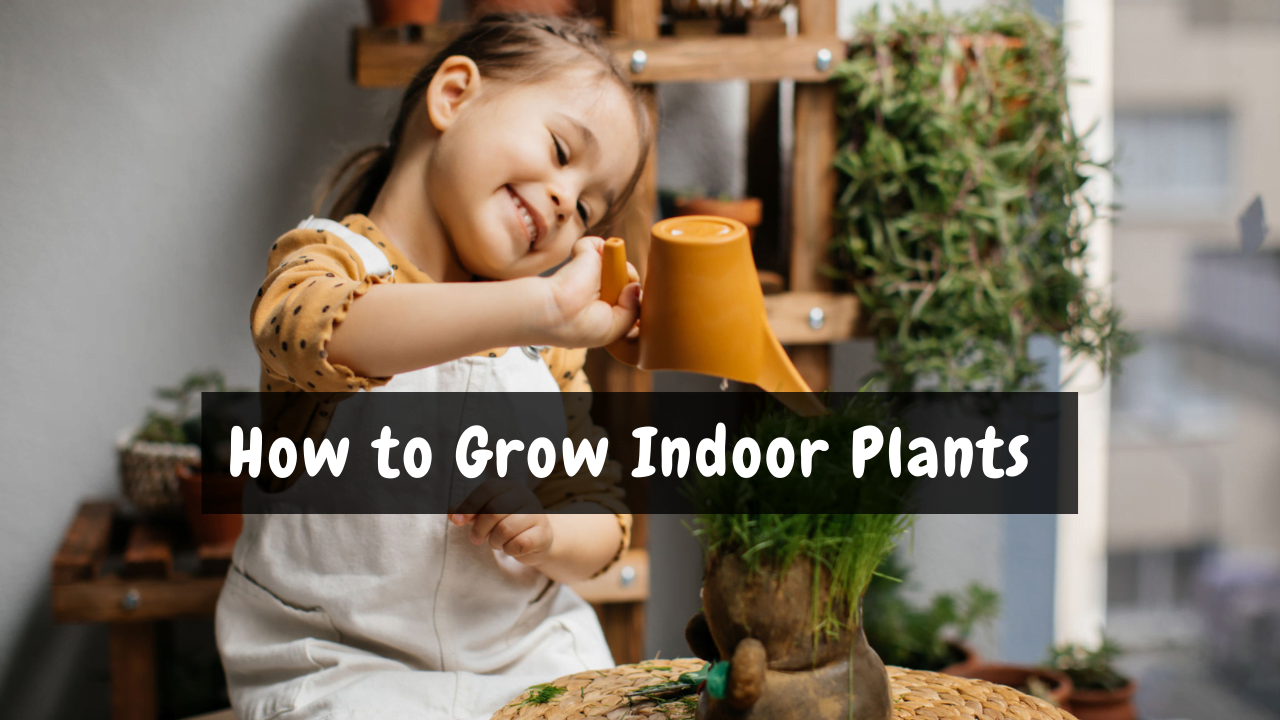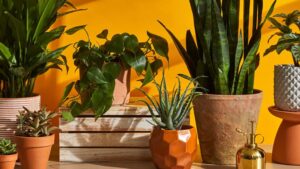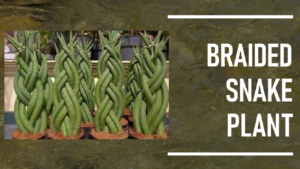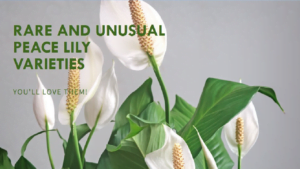Outdoor plants can be a good choice, but indoor plants are indeed a luxury that is enjoyed by many! Not everyone has room for outdoor gardening, yet one can desire to bring the wild into the home. But are you unsure how to grow indoor plants at home? Don’t worry; we will guide you over the same.
In this article, we will direct you in three ways on how you can bring the greenery back to your home.
- How to grow indoor plants from seeds?
- How to grow indoor plants in water?
- How to grow indoor plants at home?
Before that, get to know what indoor gardening is.
Indoor Gardening
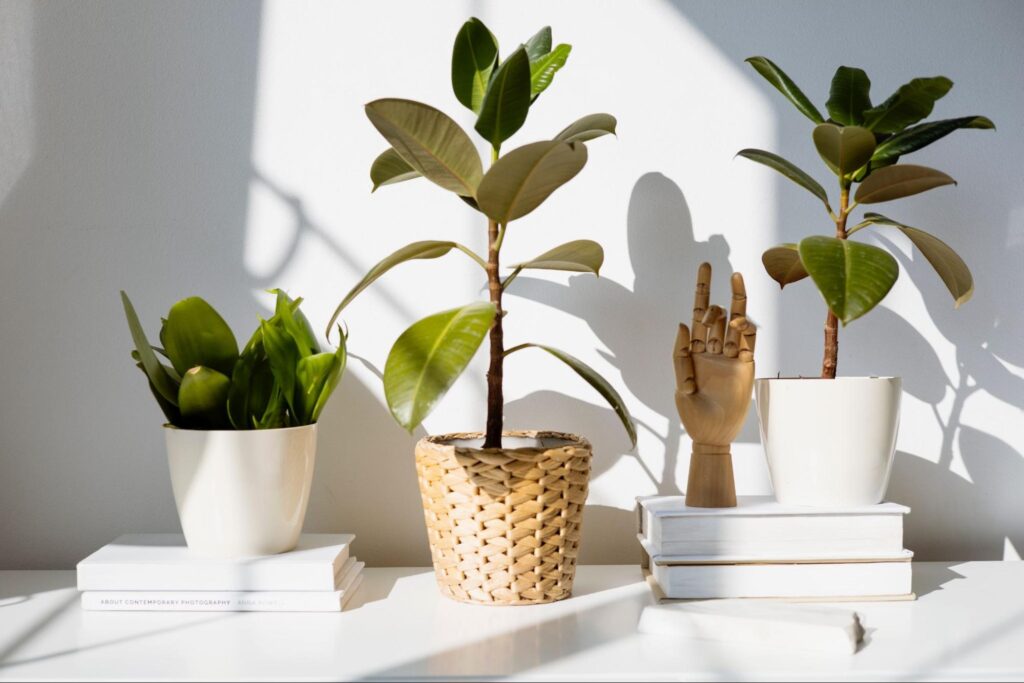
Growing a variety of plants—whether they be fruits, vegetables, herbs, or flowers—inside the home that you would typically cultivate outside is indoor gardening.
You can sense that growing plants indoors gives you an upper hand in experimenting a lot and growing your favorite plants. Indoor gardening can be more time-efficient and productive if you have the correct setup and space.
You can simply manage the environment and control the temperature according to your plants for them to thrive well. All you have to do is select the plants according to your home environment or create a surrounding so they can easily adapt.
In contrast to many outdoor gardens where the temperature determines the growing season, if the conditions are correct, you can have access to things like vegetables or herbs year-round indoors. Isn’t that great? The incredible feeling of the positive and freshness next to you!
Without further delay, we will guide you on how to grow indoor plants from seeds at your place.
How to grow indoor plants from seeds?
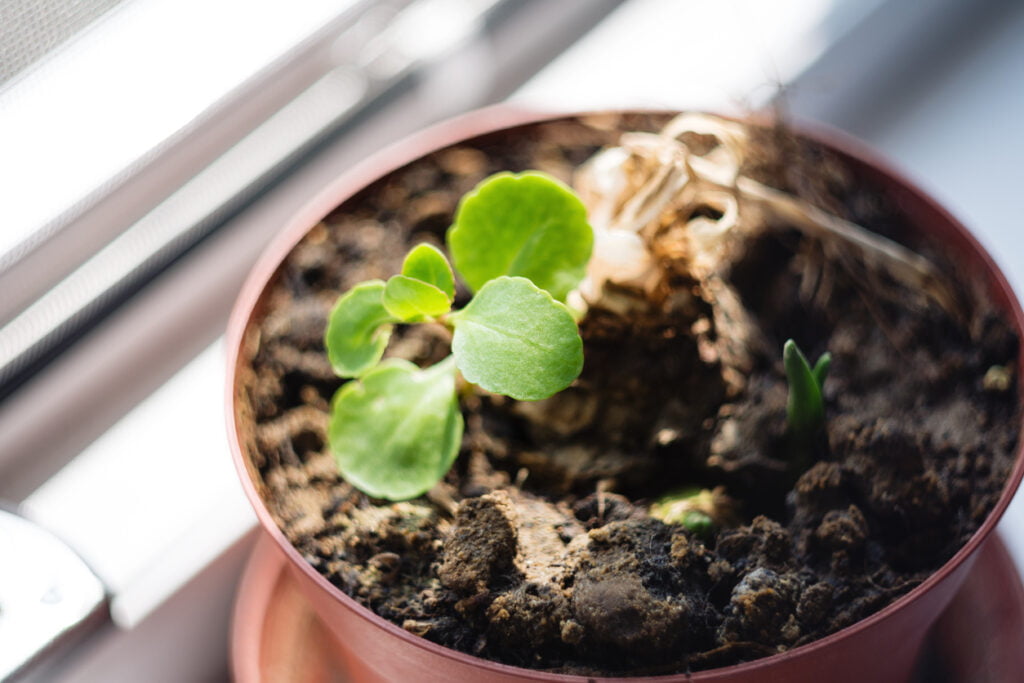
Things you need to consider while growing plants from seeds:
- You should have some healthy seeds that can sprout well and thrive in plants.
- A suitable location with indirect bright light and sufficient humid levels is ideal.
Steps to grow indoor plants from seeds:
- You should select a tiny container for the seeds. Your container should be wide enough to wet the seeds while having the space for the seedling to expand, grow and form roots.
- Place your container in bright indirect light as it will aid in photosynthesis. It will be ideal if you use well-draining soil as the initial roots will require some assistance in draining.
- Spray on your seedling and leave it.
- After a while, you will witness sprout. Now spray it once a day to keep it moist.
Note: Do not let your seedlings become too dry.
- You should keep your seedling in the container till you witness genuine leaves. Unlike the first two seedling leaves, which mimic generic plants, these leaves resemble the plant’s actual leaves.
- After some time, you can plant it in a bigger container or pot.
How to grow indoor plants in water?
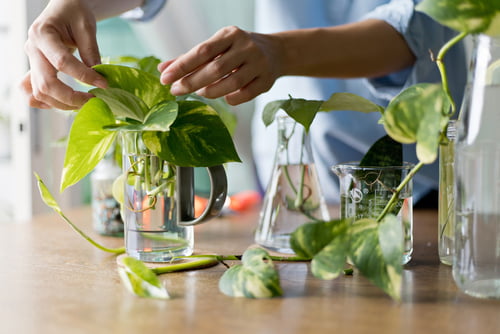
Growing indoor plants in water with a cutting is a very simple procedure. Nothing can go wrong with the steps mentioned below:
1) Selecting a medium to grow plants
You can pick any vase or old water bottle for this purpose. Be careful while selecting the medium to grow your indoor plants. If it has a short neck, you might not be able to remove the plant once it has been established. Or unless you’re ready to sacrifice the bottle.
2) Water for the plant
You can use the tap water if the standard is good enough. However, if you believe the water may be overly chlorinated, chloramine, or heavily filtered, eliminating all nutrients, you should use bottled or rain water instead.
3) Location and light for better development
You should be particular about the location of your indoor plant. New cuttings generally dislike being in direct sunlight, and the water in a transparent vase can heat up quickly. You should place it in bright, indirect lighting.
Note:
- Do not place it in cold and dry areas. You will get the best results in a warm but not hot location.
- To prevent the stem from falling over and/or from having all uneven new growth, you might need to stabilize it.
4) Wait for them to grow bigger.
All patience is worth it for beautiful green plants. Isn’t it? If you choose a vigorous grower and it is summer, you can notice root growth in as little as a couple of days. You’ll probably have to wait longer if the plant is slow-growing and it’s winter hibernation time.
5) Repot your plant
If your plant is big enough, and you want to grow your plant in soil, you can repot it into a container. Choose a large pot and follow the guidelines mentioned below for healthier and better growth of the indoor plants.
How to grow indoor plants at home?
- Take a big container or pot.
- Fill the pot with well-draining soil and make space in the middle for the plant to sit comfortably.
- Place your plant and gently spread a layer of soil.
- Water your plant regularly.
- You can add fertilizer to boost growth.
There are various things to consider while growing plants indoors. We have discussed everything in detail for you to know how to grow indoor plants at home.
1) Selecting a Pot

When selecting a pot for indoor plants, consider the quality, structure, size, and drainage capacity. You should choose a pot or container appropriate to the size of your plant right now, not much broader in diameter than your plant’s root mass.
You can transfer the indoor plant into a bigger pot after it outgrows its current one. However, if you plant a seed in a pot that is bigger than it needs to be, the roots will not take up water as quickly as it evaporates through the soil.
Pots for different indoor plants:
- Plastic pots will be an ideal pick if you are looking for shelves or hanging baskets as they are lightweight.
- Terra cotta pots are perfect for use on table tops or the floor as they are heavier and can handle heavy plants.
- Regarding decorative pots, factors such as ceramics, baskets, etc., taste, decor, and price all come into play. Abana Homes offer a wide variety of pots to meet any purpose. Check out our collection!
Note:
You should purchase a pot or container with a drainage hole. The hole at the bottom will allow the excess water to drain quickly, preventing the plant from root rotting.
2) Space

Consider space for your plants carefully to prevent them from outgrowing their appropriate location too soon. Small indoor plants, such as baby cacti, and little succulents, are simple to move.
Large indoor plants, such as indoor citrus trees, could only be appropriate for one or two sun-filled rooms in your house. The beautiful indoor hanging plants, such as ivies, the string of pearls, and vining pothos, require a location away from strong winds so they can hang in peace.
3) Light

Various indoor plants have different light needs and respond to their environment differently. Finding the ideal location for your houseplants can be a fun activity that all plant parents enjoy.
If you are growing plants that need bright indirect light, you can place them next to the west-facing window or some feet away from south-facing windows.
In case you are going for the plants like the ZZ, snake, pothos, and philodendron, the ideal place will be in north and east-facing windows. They do best in low light, especially in shaded environments.
Some indoor houseplants require artificial lighting to grow, particularly in the winter and in places with shorter daylight hours. You can grow indoor plants in fluorescent or LED grow lights, which feature full-spectrum bulbs. It balances cool and warm light to match the natural solar spectrum because regular household light bulbs are ineffective at indoor lighting plants.
4) Soil
Indoor plants can maintain their best appearance, starting with the ideal residence for their roots. You can use a well-draining potting soil blend to grow your plants, which is essential for their health.
Good potting soil with the perfect ratio of nutrition, aeration, and water absorption, aids in the growth of plant roots. You can also use peat moss, chopped pine bark, and perlite in potting soil mixtures. It helps maintain the moisture and prevents your plants from struggling from being either too wet or too dry.
5) Water

Depending upon the species you are growing, learn about its watering requirements. You should water your indoor plants with distilled room-temperature water. Your plants may occasionally be shocked by cold tap water.
With succulents being a noticeable exception to this rule, you need to provide them with occasional soakings. Most plants only require one or two waterings every week and much less in the winter.
Every plant has different watering demands. In this case, you can insert your finger two inches into the earth, and it will allow you to determine whether your plant needs to be watered or not. You should water it if it is dry.
Note:
- You should not water your plants with cold water as it may give them a shock.
- Overwatering is one of the biggest issues with indoor gardens. It leads to root rooting and the plant’s death.
6) Temperature
One of the main advantages of indoor gardening is you can regulate the humidity and temperature of a space. Most indoor plants do best in environments between 65 and 75°F during the day and roughly 10°F colder at night.
7) Humidity
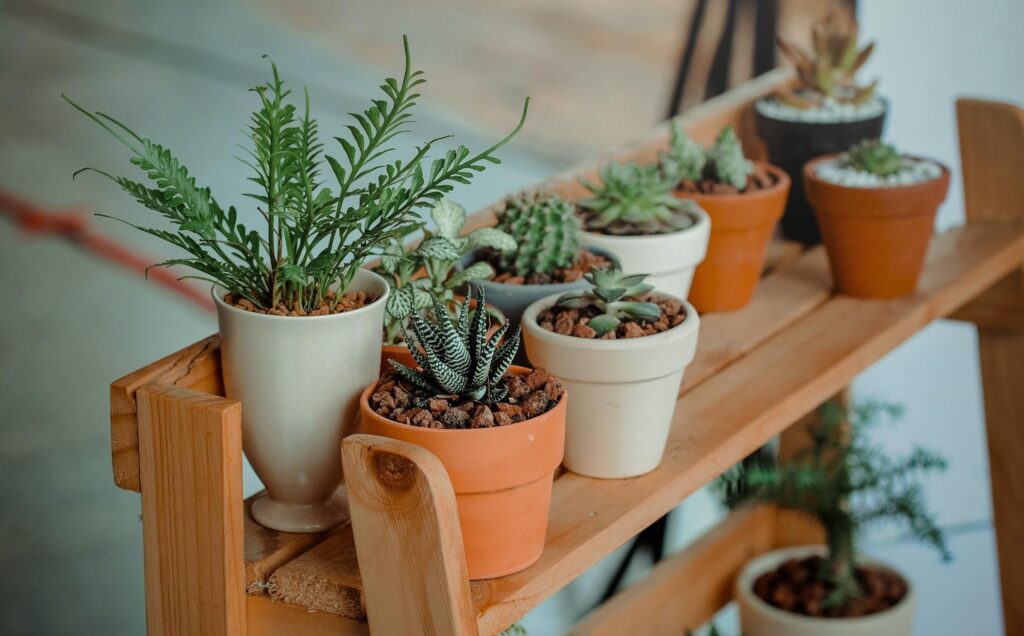
In general, indoor plants grow well in a humid environment. The majority of indoor plants perform best at humidity levels between 40 and 60%.
You can grow various indoor plants all year round because you can control and optimize the temperature and moisture within your homes.
You may easily raise the humidity in these ways to maintain the health and happiness of your plants:
- You can mist your indoor plants several times every day.
- To create a humidity tray, you can fill a tray with tiny pebbles or polished stones. You should place your plant on top of the watered pebbles, just below the surface. The air around your plant becomes more humid as water vapor escapes from it.
- Make a group of your plants. Transpiration is the mechanism through which the water leaves of plants evaporate. The plants mutually humidify each other when this happens.
8) Fertilizer
Plants grown in pots or planters do not have constant access to the nutrients provided by the soil like earth-bound plants do. Over time, the potting soil’s nutrients deplete, endangering the health of your plants.
You can refill the nutrients in the potting soil regularly to promote sustained, healthy indoor plant growth. Fertilize your indoor plants once a month when they are expanding or blooming. You can cut back on or stop using fertilizer throughout the winter when plants tend to remain dormant.
9) Pruning
You can prune your indoor plants in the spring and summer. It is the best way to keep them tidy and attractive. You can use the herb shears or pruning shears to remove any wasted blooms and dead foliage regularly.
Clean leaves can better purify the air inside your home and produce oxygen, so wipe them down frequently to get rid of dust and accumulation.
10) Pests and Diseases
Your indoor plants might suffer damage from pests, including aphids, mealybugs, spider mites, and white flies.
Just be aware that an infestation may undoubtedly affect your plants at some point. They steadily drain a plant of its sap, weakening it over time, stunting its growth, and deforming its flowers.
You should look for infestation indications weekly. Keep a check for insects, holes in the leaves, and sticky materials that bugs exude while feeding. If you have other members in your plant family, immediately isolate the damaged houseplant if you discover pests.
If you see any pests, you can spray an insecticidal soap, typically kept in a spray bottle. Spray the entire plant, including the stem, undersides, and tips of the leaves, as soon as you spot bugs.
Then, after waiting around two weeks, repeat the procedure. You can also use a wet paper towel to get rid of a pest or neem oil spray.
11) Repotting

You should keep an eye on your indoor plants as they might require repotting every year or so. Slowed development and roots emerging from drainage holes or growing above the soil line can be indicators.
You should opt for one slightly big pot size at a time; avoid going too big, too quickly. Larger pots entail more soil and water, which might result in fungus and root rot. You should repot your plants for their continued growth.
Now, we will cover some of the most asked questions on growing indoor plants at home.
Frequently Asked Questions
Ques1: Which indoor plants are easygoing?
Ans: These are some of the most trouble-free plants:
- Snake plant
- Philodendron
- Most succulents
- Pothos
- ZZ plant
Ques2: What are some of the best indoor plants?
Ans: Good houseplants can withstand reduced light and humidity levels. Additionally, they won’t have to deal with bugs as often.
Additionally, they often don’t grow very much (you wouldn’t want an indoor plant to grow quickly). The following are some of the top houseplants:
- Aglaonema
- Succulents
- Dracaenas
- Snake plant
- Pothos
- Philodendrons
Ques3: How can I care for my indoor plants?
Ans: The following advice will assist you in taking care of indoor plants:
- Keep the potting soil moist; avoid having the soil become excessively damp or dry.
- Make certain the plant container has drainage holes in the bottom.
- Put your plant next to a source of light, whether it be natural or artificial.
- Find out what kind of plant you have so that you can properly care for it.
Ques4: Are indoor plants too pricey?
Ans: The cost of indoor plants is generally pocket-friendly. The cost of the plant will decrease with its size. The price of the plant also depends upon the species and age. You can go through our store for the best quality plants at a reasonable price.
Ques5: Can indoor plants complement my decor?
Ans: The ability to use fashionable indoor plants to enhance your home’s décor is one of the best things about growing indoor plants.
Although containers are a factor, plants themselves provide color, texture, and structure to reflect your unique style and highlight current design trends. Beautiful indoor plants suit any aesthetic, from boho to mid-century.
- Monstera deliciosa, rubber plants, and fiddleleaf figs all make bold statements with their distinctive personalities and striking foliage.
- Strong ZZ plants blend color and dramatic form in shades ranging from glossy green to raven black.
- Spiky snake plants emphasize angular interest and vertical lines in hues ranging from moonshine green to golden stripes.
- Depending on the amount of light, crotons can erupt in different combinations of orange, red, yellow, pink, and purple.
Ques6: How much will it take for a seedling to grow?
Ans: On average, a seedling takes about a week to grow. But it varies with the species you are growing, and it might take one to two weeks to sprout.
Ques7: How to choose indoor plants?
Ans: You should carefully examine the plants for excellent health, including normal-sized growth, properly formed leaves or buds, firmly-anchored stems, and general color and appearance.
Just because they seem great doesn’t mean they are! Have a detailed look at their texture and form. Avoid indoor plants with wilted or drooping leaves, mushy stems, tiny and shriveled growth, or wet soil. They might be beyond saving or sick.
Excessively brown leaves, fallen or fading leaves, extended stems, and apparent insect infestations are all warning signals.
Conclusion
Indoor plants give you the honor of bringing back the wild into your home. By unleashing your creative and caring side of yours, it boosts your mental peace. Having green companions nearby creates an appealing aura.
If you are still overwhelmed with how to grow indoor plants at home, do mention your queries in the comment, and we will get back to you!
Related Articles
- 15 Best Plants for Front Door Entrance India | Auspicious plants for front door
- 10+ Money plant Benefits That Will Make you Keep It In Your House
- Are Spider Plants Toxic to Cats?- 4 Ways To Prevent Your Cats From Eating Spider Plants.
- Best Plants for the House – 8 Top Apartment Plants That You Can’t Miss
- How to Braid Your Snake Plant: Tips and Care Guide
- 20+ Rare and Unusual Peace Lily Varieties You’ll Love

